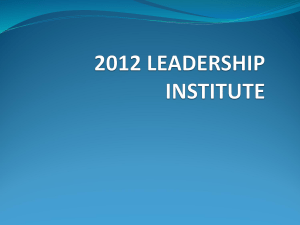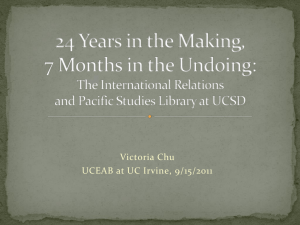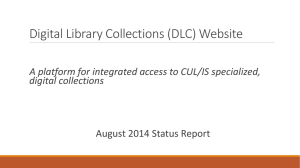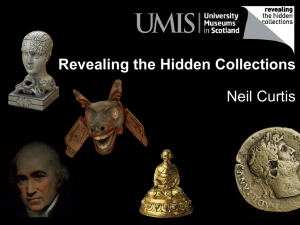Centralized Collections
advertisement
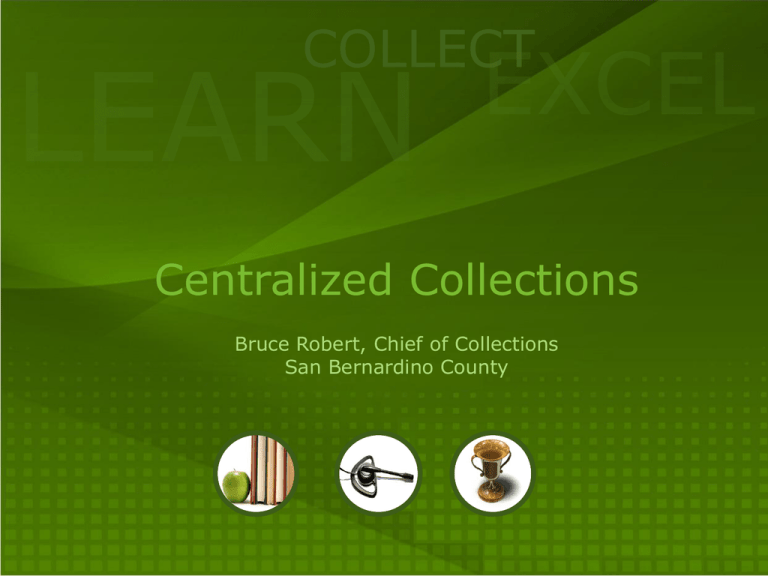
COLLECT Centralized Collections Bruce Robert, Chief of Collections San Bernardino County COLLECT Centralized Collections vs. Stand Alone Units Discussion Topics • Considerations for Centralization • Comparison of Centralized vs. Stand Alone • Establishing Centralized Collections • Model for Centralized Collections • Questions and Answers Note: Topics are presented from a county perspective, although concepts can relate to city, state or federal level. Considerations for Centralization • Participating Agencies • Political Issues • Funding • Staffing • Technology • Level of Expertise COLLECT Participating Agencies Typical Agencies Include: • Courts – Criminal Cases – Traffic Infractions – Juvenile Cases • County Medical Center • Unsecured Property Taxes • Variety of smaller departments COLLECT Political Issues • CAO Support • If you centralize, where will you go? – Treasurer-Tax Collector – Auditor Controller – Stand-alone Department • Do separate collection units exist? • Resistance to centralization COLLECT Funding • Current Funding • Continuation of current funding • Sources of Funding – – – – – – – Local Cost General Administrative Budget Commission Collection Fee Fee Based Cost Offset (PC 1463.007) Grants COLLECT Staffing • Current available staffing • Will new agencies participate? • Impact on current staffing • Ability to add additional staff COLLECT Technology • What technology is available? • What are the future requirements? • Will you have sufficient IT budget? • Will you have sufficient support staff? COLLECT Level of Expertise • Management’s level of expertise • Subject matter experts • Required training • Current policies and procedures Comparison of Centralized Collections vs. Stand Alone Units COLLECT Comparison Centralized Collections • Centralized Management • Standards – more consistency • Shared resources – more cost effective • Harder to manage knowledge transfer – more topics among more people • Centralized technology – easier to manage – more cost effective Stand Alone Units • Segregated Management • Lack of standards – less consistency • Segregated resources – less cost effective • Easier to manage knowledge – fewer topics among fewer people • Segregated technology – more complicated – less cost effective Establishing Centralized Collections COLLECT Establishing Centralized Collections • Gain support for concept • Determine where to place organization • Establish scope – mandatory/elective participation by departments • Develop client list • Determine resources • Establish funding sources COLLECT Establishing Centralized Collections • Determine rates for commission/fees • Determine start up costs • Establish budget • Determine staffing level • Sufficient subject matter experts • Decision: Consolidated work force vs. separate business units Model for Centralized Collections COLLECT Model for Centralized Collections San Bernardino County • Court Collections • Medical Center • Unsecured Property Taxes • Various Smaller Agencies COLLECT Model for Centralized Collections Original Organization Three Stand Alone Units: • Collections Division (Medical) • Probation Accounting (Court) • Treasurer-Tax Collector (Unsecured) COLLECT Model for Centralized Collections Centralization: • Grand Jury Report recommendation • CAO supported concept • Creation of Central Collections • Departments merged under Treasurer-Tax Collector COLLECT Model for Centralized Collections History: • Collections Division and Probation Accounting Merged • Maintained Separate Business Units • Added Unsecured Property Tax Division • Added Traffic Infraction Unit COLLECT Model for Centralized Collections Staff is divided by business units • Medical Center • Adult Misdemeanors/Felonies • Juvenile Cases • Traffic Infractions • Unsecured Property Taxes • Various Smaller Clients • Legal Org Chart COLLECT for San Bernardino County Collections Treasurer/Tax Collector Asst Treasurer/Tax Collector Chief of Collections Chief Supervising Collections Officer Collection Spvr (2) Medical (19) Collection Spvr (1) Adult Court (9) Juvenile (4) Collection Spvr (1) Collection Spvr (1) Collection Spvr (1) Traffic (10) Unsecured (6) Legal (7) COLLECT Model for Centralized Collections Funding • Operate with No Local Cost • Blend of Funding Sources • Courts: Cost Offset (PC 1463.007) • Medical: Cost Plus Commission • Unsecured: Collection Fee per Account • Smaller Clients: Commission • More Difficult Collections: Fee Based COLLECT Model for Centralized Collections Each unit has their own goals: • Monthly Collection Quota • Daily # of accounts worked • Daily # of phone calls • Monthly # of legal referrals • Monthly # of payment plans set This varies from unit to unit. COLLECT Model for Centralized Collections Statistics Tracked by Business Units • Monthly Collections • Cost of Collections • Recovery Rates • Total Outstanding Accounts Receivable We have annual targets for each unit. COLLECT Model for Centralized Collections Separate Business Units • Greater level of expertise Less overall knowledge • Less training required • Fewer staff under privacy regulations • More difficult to manage customer service (fewer staff members to handle calls) • Easier to track costs • Easier to shift effort to a particular client Consolidated Work Force • Greater level of overall knowledge – less expertise • More training required • All staff subject to privacy regulations • Easier to manage customer service (all staff can handle all account types) • More difficult to track costs • Hard to shift a concentrated effort on a particular client COLLECT Model for Centralized Collections San Bernardino County • Separate business units is preferred – Easier to track costs – Easier to develop knowledgeable staff – Can ramp up efforts for a particular client easily – Able to set standards for each unit based on level of effort to collect COLLECT Model for Centralized Collections Practical Day-To-Day Issues (Each is Business Unit Specific) • Work Lists: Each collector has a specific workload • Letters: Have over 500 letters • Action Codes: Collectors use codes for account follow up • Legal Referrals: Dedicated legal collectors for each business unit COLLECT Model for Centralized Collections Practical Day-To-Day Issues (cont’d) • Receivables Management: Procedures to deal with aging receivables • Statistics: Tracked by business unit • Shared Resources: Most are shared with a few business specific resources Questions? Thank You! Contact Information: Bruce Robert Chief of Collections San Bernardino County (909) 387-5616 brobert@ttcpa.sbcounty.gov
